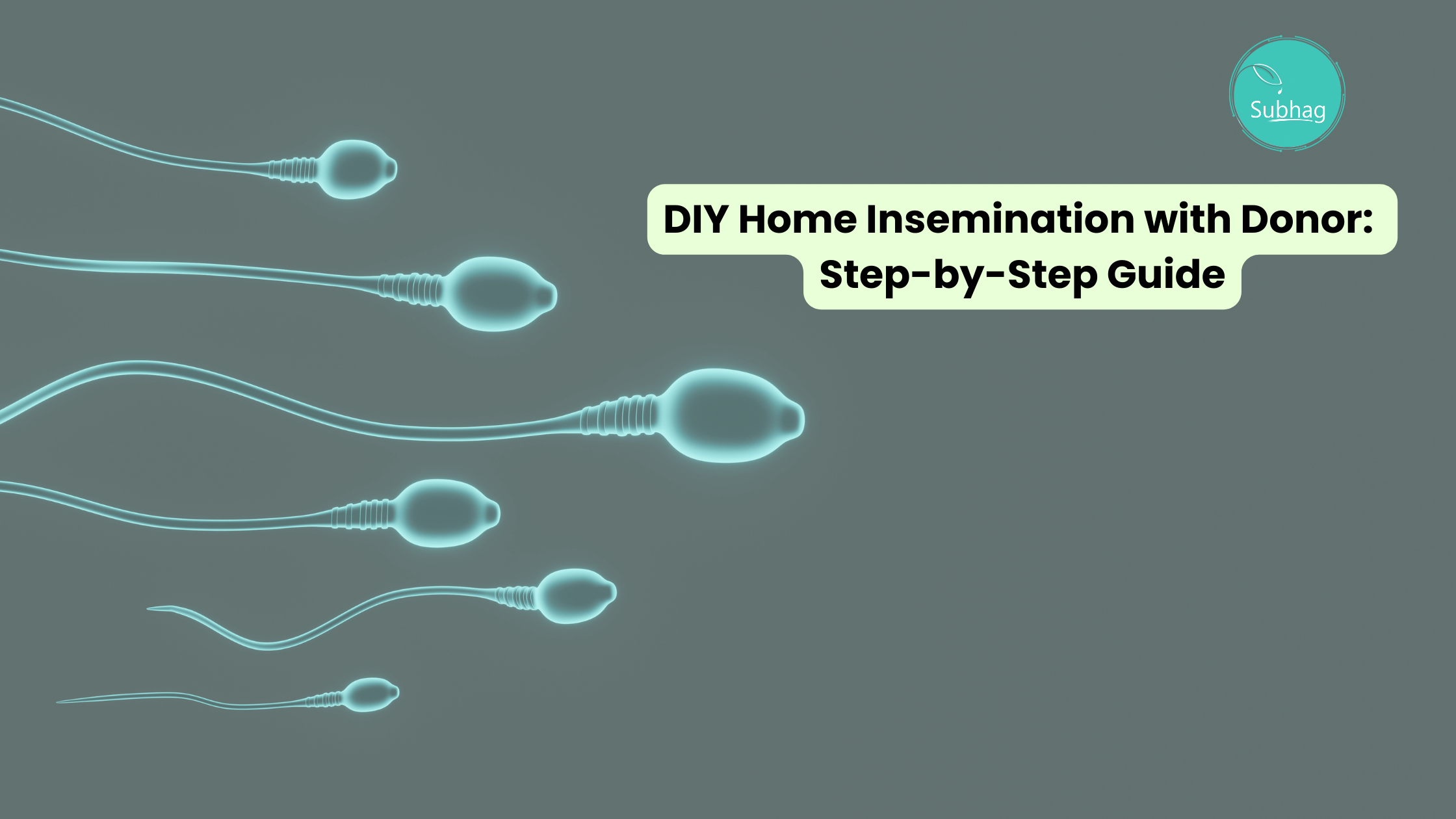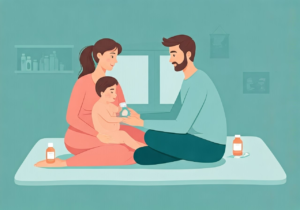Introduction
Trying to conceive a child is an exciting and joyous journey for many couples. However, for some, it can be a challenging process that requires assistance. When natural conception is not possible or has proven difficult, fertility treatments such as artificial insemination or IVF can offer hope. In this blog, we will explore the process of DIY home insemination with a donor as the first step towards parenthood. We will provide a step-by-step guide to help you understand the basics, prepare for the insemination, and increase your chances of success.
Key Highlights
Artificial insemination is a fertility treatment method that can help couples who are struggling to conceive.
- are two main types of artificial insemination: intrauterine insemination (IUI) and intracervicalmination (ICI).
IUI involves inserting specially prepared sperm into the uterus, while ICI involves inserting sperm into the cervix.
- Artificial insemination can be performed at a doctor’s office or at home, depending on the chosen method.
- The success rates of artificial insemination vary depending on various factors such as age, fertility issues, and the type of insemination used.
- Artificial insemination can be a more affordable and less invasive option compared to other fertility treatments.
Understanding DIY Home Insemination
Artificial insemination is a fertility treatment method used to deliver sperm directly to the cervix or uterus, increasing the likelihood of a successful pregnancy.
It can be a viable option for couples facing fertility issues or those who do not have a partner with sperm, such as same-sex couples.
Two chief approaches to artificial insemination exist: intrauterine insemination (IUI) and intra cervical insemination (ICI).
However, if these options are not suitable, a doctor may recommend a different fertility treatment called in vitro fertilization (IVF), which involves extracting eggs from one parent and sperm from another and fertilizing them in a clinical setting.
In IUI, specially prepared sperm is inserted into the uterus. This procedure can be performed at a doctor’s office and usually involves the use of fertility medications to stimulate ovarian follicle growth and increase the chances of conception.
On the other hand, ICI involves inserting semen into the cervix or uterine cavity. This type of artificial insemination can be done in a doctor’s office or at home.
The Basics of Donor Sperm Insemination
In order to undergo artificial insemination with donor sperm, a sperm sample is required.
This sample can be obtained from a sperm bank, where donors have already been screened and their sperm has been frozen and stored for future use.
The sample is typically washed or “prepared” to remove potential proteins that could affect fertilization.
The sample is then stored in a vial and shipped to the recipient with instructions and all necessary materials for the insemination process, including the shipment of the donor sperm vial.
Couples may choose to use donor sperm for various reasons.
Some individuals may have a genetic defect that they do not want to pass on to their child, while others may have a low sperm count or low sperm motility.
Donor sperm insemination provides an opportunity for individuals and couples to conceive and start a family.
Why Choose Home Insemination?
One of the main reasons why couples choose home insemination is the privacy and comfort of their own home.
Performing the insemination in a familiar environment can help alleviate any stress or discomfort associated with clinical settings.
Additionally, home insemination allows for flexibility in terms of timing and scheduling, making it easier to work around personal commitments and fertility cycles.
By choosing to inseminate at home, you can create the atmosphere you want and have complete control over the privacy of your own home, promoting overall wellness.
This can also save you additional medical costs associated with fertility treatments done by a clinician.
Home insemination can also be a suitable option for couples experiencing unexplained infertility, where no underlying cause for the fertility issues has been identified.
It can also be a preferred choice for those who want a less invasive form of artificial insemination compared to IUI or sexual intercourse.
However, it is important to note that home insemination may not be as regulated as medical office procedures, and thorough discussion and understanding of the process and its risks, as well as the intimacy involved, are crucial.
Preparing for Home Insemination
Before embarking on the home insemination process, it is important to understand and track your ovulation cycle.
Knowing when you are most fertile can greatly increase your chances of successful conception.
There are several methods to monitor your ovulation cycle, including using a calendar method, tracking your temperature regularly, using ovulation predictor kits, or measuring the concentration of hormones in your urine with a device like the Mira fertility tracker.
When preparing for home insemination, it is also essential to create a clean and hygienic environment. Make sure that your vaginal canal is clean and free from any potential contaminants.
It is recommended to wash your hands thoroughly before handling any equipment or specimens. Additionally, it is important to consider any legal considerations and consent requirements, depending on your jurisdiction.
Familiarize yourself with the laws and regulations surrounding home insemination in your area, including the proper use and disposal of equipment such as a plunger and a 17 cm sterile IUI catheter.
Selecting the Right Donor
Choosing the right donor is a crucial step in the home insemination process. If you decide to use donor sperm from a sperm bank, take the time to research and select a reputable sperm bank that meets your criteria.
Consider factors such as the donor’s physical characteristics, medical history, and screening process. It is also important to ensure that the sperm sample you choose is of high quality and meets your specific requirements.
DIY home insemination with a sperm donor can be a fulfilling and intimate experience, but it is important to carefully select the right donor for your unique situation.
If you are using a known donor, such as a friend or family member, it is essential to have open and honest discussions about expectations, legal considerations, and consent.
Seek legal advice to understand the legal implications and requirements of using a known donor for home insemination.
Remember that it is important to have a clear understanding and agreement between all parties involved to ensure a smooth and legally compliant process.
Legal Considerations and Consent
When engaging in home insemination, it is crucial to be aware of the legal implications and consent requirements. The laws surrounding home insemination vary depending on the jurisdiction.
It is recommended to consult with a legal professional who specializes in fertility and reproductive law to understand the legal framework in your area.
Consent plays a significant role in the home insemination process. It is important to ensure that all parties involved, including the donor and the individual or couple undergoing the insemination, provide informed and voluntary consent.
This consent should cover all aspects of the process, including the use of donor sperm, the insemination procedure, and any legal and parental rights and responsibilities.
The Home Insemination Process Explained
The home insemination process can be performed using either the IUI or ICI method. Both methods involve the insertion of sperm into the reproductive tract, but they differ in the location of insertion.
It is important to understand the step-by-step guide for each method to ensure a successful home insemination.
Step-by-Step Guide to Insemination at Home
For ICI home insemination, the following step-by-step guide can be followed:
- Monitor your ovulation cycle using a calendar method, temperature tracking, or ovulation predictor kits.
- Obtain a sperm sample from a donor or use a sperm sample from a reputable sperm bank.
- Prepare a clean and hygienic environment for the insemination process.
- Use a special syringe to collect the sperm sample and insert it into the vagina near the cervix.
- Lie down for 15 to 30 minutes to allow the sperm to move up from the cervix into the uterus.
- Resume regular activities after the recommended resting time.
- Take a pregnancy test after approximately two weeks to determine if the insemination was successful.
Tips for Increasing Success Rates
There are several tips and strategies that can increase the success rates of home insemination. These include:
- Tracking your ovulation cycle accurately to ensure optimal timing for insemination.
- Maintaining a healthy lifestyle by eating a balanced diet, exercising regularly, and managing stress levels.
- Using the recommended techniques and equipment for home insemination, such as the correct syringe and proper insertion techniques.
- Considering additional fertility-enhancing methods, such as taking fertility supplements or undergoing acupuncture treatments.
- Seeking support and guidance from healthcare professionals, fertility specialists, or support groups.
After Insemination: What to Expect
After the insemination process, it is normal to feel a mix of emotions, including excitement, anticipation, and anxiety. It is important to be patient and understand that conception may not occur immediately. Here are some things to expect after insemination:
- Menstrual cycle: It is common for the menstrual cycle to continue as usual after insemination. However, some individuals may experience slight changes in their menstrual cycle due to hormonal fluctuations.
- Signs of pregnancy: While it may take some time for pregnancy symptoms to manifest, individuals may start noticing signs such as breast tenderness, fatigue, or mild cramping. It is important to note that these symptoms can also be attributed to other factors and may not necessarily indicate pregnancy.
- Pregnancy test: Approximately two weeks after insemination, you can take a pregnancy test to determine if the process was successful. It is advisable to follow the instructions on the pregnancy test package and consult with a healthcare professional for accurate interpretation.
Immediate Follow-up Care
After taking a pregnancy test, it is recommended to schedule a follow-up appointment with a healthcare professional. The healthcare professional can provide additional guidance, perform further tests if necessary, and monitor the progress of the pregnancy.
They may also offer support and answer any questions or concerns that you may have.
Immediate follow-up care can include a visit to a doctor’s office or a specialist’s clinic. During the appointment, the healthcare professional may conduct a physical examination, order blood tests, or perform an ultrasound to assess the viability and progression of the pregnancy.
Signs of Pregnancy to Look For
While waiting for the pregnancy test results, it is natural to be curious about potential signs of pregnancy. Some common signs and symptoms of pregnancy include:
- Missed period
- Breast tenderness
- Nausea or morning sickness
- Fatigue or increased tiredness
- Frequent urination
- Mood changes
It is important to note that these signs can vary from person to person, and not everyone will experience the same symptoms. Additionally, these symptoms can also be attributed to other factors, so it is always best to consult with a healthcare professional for an accurate diagnosis.
Addressing Common Concerns
When undergoing DIY home insemination, it is common to have concerns and questions. Here are some common concerns and their answers:
- Fertility problems: DIY home insemination can be a viable option for individuals and couples facing fertility issues. It provides an opportunity to overcome challenges and increase the chances of conception.
- Treatment cycles: The number of treatment cycles required for successful conception can vary depending on several factors, including age, underlying fertility issues, and the chosen method of insemination.
- Emotional health: Going through the insemination process can be an emotional journey. It is important to have a support system in place, whether it be through friends, family, or support groups. Seeking professional counseling or therapy can also be beneficial in managing emotional well-being during this time.
Managing Expectations and Emotional Health
When embarking on the journey of DIY home insemination, it’s important to manage your expectations and prioritize your emotional health. Fertility issues can be emotionally challenging, and it’s essential to approach the process with a realistic mindset.
Understand that conception may not happen immediately and be prepared for the possibility of multiple attempts before achieving success with the use of an embryo.
It can be helpful to seek support from your partner, friends, or a support group that specializes in fertility issues. Talking openly about your feelings and concerns can provide a sense of relief and connection with others who are going through a similar experience.
Additionally, consider engaging in self-care activities such as exercise, meditation, or therapy to help manage stress and improve your emotional well-being throughout the process.
When to Seek Professional Help
While DIY home insemination can be a viable option for many couples, there may come a time when seeking professional help is necessary.
If you have been trying to conceive through home insemination for a significant period of time without success, it may be prudent to consult a fertility specialist.
A fertility specialist can evaluate your specific situation, conduct tests to determine any potential underlying fertility issues, and provide personalized recommendations for treatment.
They can offer expertise and guidance to increase your chances of conception, whether that involves adjusting your home insemination technique, exploring alternative fertility treatments, or recommending additional medical interventions.
It’s important to remember that fertility specialists are trained professionals who can provide valuable insight and assistance throughout your journey to parenthood. Don’t hesitate to reach out for help when you feel it may be necessary.
Conclusion
In summary, DIY home insemination can be a deeply personal and empowering journey for many individuals or couples.
By understanding the process, preparing diligently, and addressing common concerns, you can navigate this path with confidence. Remember to prioritize your emotional well-being and seek professional help if needed.
For answers to more specific questions or concerns, feel free to explore our related blog on fertility options. Your journey towards parenthood is unique, and we’re here to support you every step of the way.
Frequently Asked Questions
Can DIY home insemination work with frozen sperm?
Yes, DIY home insemination can work with frozen sperm. However, it’s important to follow the specific instructions provided by the sperm bank or fertility clinic regarding thawing and handling the frozen sperm. The specimen should be thawed to room temperature before use to ensure the highest chances of success.
How many attempts should we try before consulting a fertility specialist?
The number of attempts before consulting a fertility specialist can vary depending on various factors such as age, overall health, and underlying fertility concerns. In general, it is recommended to try home insemination for six months to a year before seeking professional help. However, if you have known fertility issues or are experiencing difficulties, it may be beneficial to consult a specialist earlier.
Are there any legal implications of using a known donor for home insemination?
Using a known donor for home insemination can have legal implications. It is important to establish clear legal agreements and obtain consent from all parties involved to ensure that everyone’s rights and responsibilities are protected. Consulting with a lawyer who specializes in reproductive law can provide necessary guidance and ensure that the process is legally sound.
How can we ensure the highest quality of donor sperm for home insemination?
To ensure the highest quality of donor sperm for home insemination, it is recommended to obtain sperm from a reputable sperm bank. Sperm banks carefully screen and test donors to ensure the quality and safety of the sperm. Working with a trusted sperm bank can provide peace of mind and increase the chances of successful insemination.
What are the risks associated with home insemination?
While home insemination is generally considered safe, there are some risks associated with the procedure. These risks include the possibility of infection if proper hygiene and sterilization practices are not followed, as well as the potential for unsuccessful insemination or conception. It is important to follow all instructions provided by healthcare professionals and take necessary precautions to minimize these risks.
Can lifestyle changes improve the chances of conception through home insemination?
Certain lifestyle changes can improve the chances of conception through home insemination. Maintaining a healthy diet, managing stress levels, regular exercise, and avoiding smoking and excessive alcohol consumption can positively impact fertility. Additionally, tracking ovulation and timing insemination accordingly can increase the likelihood of successful conception.
How do we choose between fresh and frozen sperm for home insemination?
The choice between fresh and frozen sperm for home insemination depends on individual preferences and circumstances. Fresh sperm may have higher chances of success due to its immediate availability, while frozen sperm offers the convenience of storage and the ability to plan insemination timing. It is important to consider factors such as cost, availability, and personal preferences when making this decision.
What resources are available for couples considering home insemination?
There are various resources available for couples considering home insemination. Online support groups and forums provide a platform for individuals to connect with others who have gone through similar experiences. Additionally, there are websites and organizations that offer information and guidance on home insemination, fertility treatments, and reproductive health.




